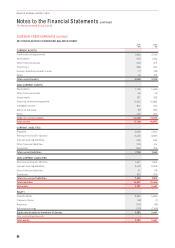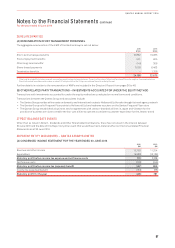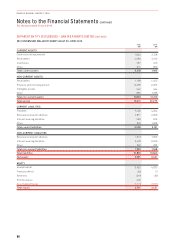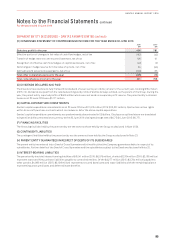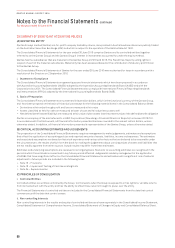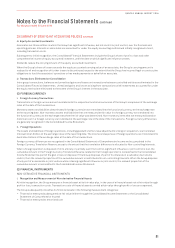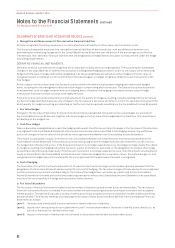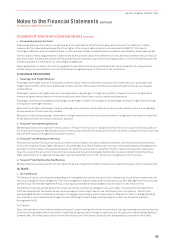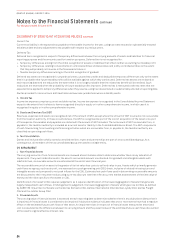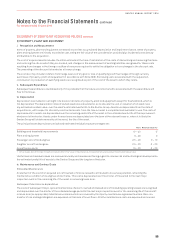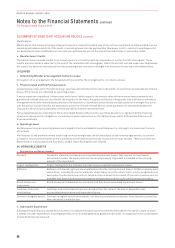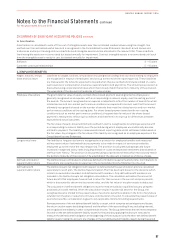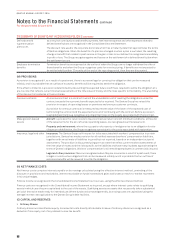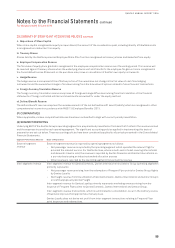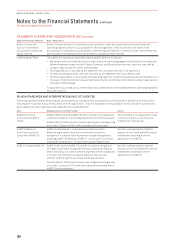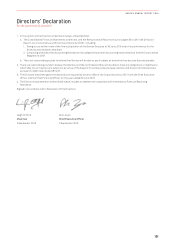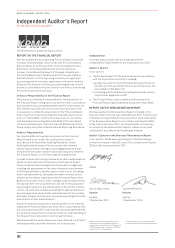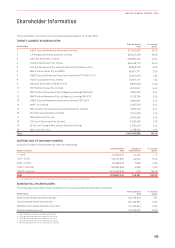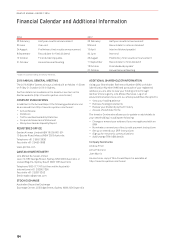Qantas 2016 Annual Report Download - page 98
Download and view the complete annual report
Please find page 98 of the 2016 Qantas annual report below. You can navigate through the pages in the report by either clicking on the pages listed below, or by using the keyword search tool below to find specific information within the annual report.
Notes to the Financial Statements continued
For the year ended 30 June 2016
29 SUMMARY OF SIGNIFICANT ACCOUNTING POLICIES CONTINUED
Modifications
Modifications that enhance the operating performance or extend the useful lives of aircraft are capitalised and depreciated over the
remaining estimated useful life of the asset or remaining lease term (as appropriate). Manpower costs in relation to employees who
are dedicated to major modifications to aircraft are capitalised as part of the cost of the modification to which they relate.
v. Manufacturers’ Credits
The Qantas Group receives credits from manufacturers in connection with the acquisition of certain aircraft and engines. These
credits are recorded as a reduction to the cost of the related aircraft and engines. Where the aircraft are held under operating leases,
the credits are deferred and reduced from the operating lease rentals on a straight-line basis over the period of the related lease.
(J) LEASES
i. Determining Whether an Arrangement Contains a Lease
At inception of an arrangement, the Group determines whether the arrangement is or contains a lease.
ii. Finance Leased and Hire Purchase Assets
Leased assets under which the Qantas Group assumes substantially all the risks and benefits of ownership are classified as finance
leases. Other leases are classified as operating leases.
Finance leases are capitalised. A lease asset and a lease liability equal to the present value of the minimum lease payments and
guaranteed residual value are recorded at the inception of the lease. Any gains and losses arising under sale and finance leaseback
arrangements are deferred and depreciated over the lease term. Capitalised leased assets are depreciated on a straight-line basis
over the period in which benefits are expected to arise from the use of those assets. Lease payments are allocated between the
reduction in the principal component of the lease liability and the interest element.
Fully prepaid leases are classified in the Consolidated Balance Sheet as hire purchase assets to recognise that the financing
structures impose certain obligations, commitments and/or restrictions on the Qantas Group, which differentiate these aircraft
fromowned assets.
iii. Operating Leases
Rental payments under operating leases are charged to the Consolidated Income Statement on a straight-line basis over the term
ofthe lease.
With respect to any premises rented under long-term operating leases, which are subject to sub-tenancy agreements, a provision
is made for any shortfall between primary payments to the head lessor less any recoveries from sub-tenants. These provisions are
determined on a discounted cash flow basis, using a rate reflecting the cost of funds.
(K) INTANGIBLE ASSETS
i. Recognition and Measurement
Goodwill Goodwill is stated at cost less any accumulated impairment losses. With respect to investments
accounted for under the equity method, the carrying amount of goodwill is included in the carrying
amount of the investment.
Airport landing slots Airport landing slots are stated at cost less any accumulated impairment losses.
Software Software is stated at cost less accumulated amortisation and impairment losses. Software development
expenditure, including the cost of materials, direct labour and other direct costs, is only recognised as an
asset when the Qantas Group controls future economic benefits as a result of the costs incurred and it is
probable that those future economic benefits will eventuate and the costs can be measured reliably.
Brand names and
trademarks
Brand names and trademarks are carried at cost less any accumulated impairment losses.
Customer contracts/
relationships
Customer contracts/relationships are carried at their fair value at the date of acquisition less
accumulated amortisation and impairment losses.
Contract intangible assets Contract intangible assets are stated at cost less accumulated amortisation. Amortisation commences
when the asset is ready for use.
ii. Subsequent Expenditure
Subsequent expenditure is capitalised only when it increases the future economic benefits embodied in the specific asset to which
it relates. All other expenditure, including expenditure on internally generated goodwill and brands, is recognised in the Consolidated
Income Statement as incurred.
96
QANTAS ANNUAL REPORT 2016


